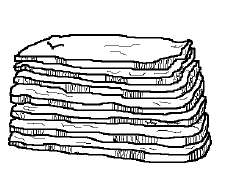Soil Structure
Soil structure is the arrangement of the primary soil particles (sand, silt, and clay) and other soil materials into discrete aggregates.
Classification is based upon –
1. Type (shape and arrangement of peds),
2. Class (size of peds) and
3. Grade (durability of peds).
Peds
• Peds consist of primary particles bound together by cementing agents like organic matter, clay, and hydrous oxides of iron and aluminum.
• They are the structural units that have distinct boundaries and well-defined planes of weakness.
• Based on shapes and arrangements of peds/ aggregates, soil structure is of 4 principal types:
Ped Shapes
• Plate like
• Prism like
• Block like
• Spheroidal
Platy Structure
• Thin, flat plates of soil that lie horizontally.
• Usually found in compacted soil in any part of the profile
• Aggregates are arranged in a plate-like arrangement.
• Due to compaction
Prism like
• Vertically oriented aggregates common in sub-surface horizons of arid/semi-arid regions.
• 2 subtypes- Columnar (natric) and prismatic
Prismatic Structure
• Vertical columns of soil
• Usually found in lower horizons of dry and salt-affected soils.
Columnar Structure
• Round edges
• Found in soils of arid climates.
Blocky Structure
• Irregular 6 faced blocks
• Can be subangular or angular blocky.
• Aggregates look like blocks, sizes 1 to 10 cm.
• Subtypes- angular and subangular.
• Subsoils of humid regions.
Spheroidal Structure
• Commonly found in surface horizons
• Surface soils are rich in OM.
• 2 subtypes- Granular (nonporous) and Crumbs (porous).
• Subject to rapid changes, affected by farming practices
2. Class
Various sizes of aggregates/peds are designated by various classes i.e.
<1mm very fine class
- 1-2 mm fine class
- 2-5mm medium class
- >5mm large class
3. Grade
Degree of aggregation/durability
3 grades- weak, moderate, and strong
Single-grained/structureless
• Soil is broken into individual particles
• Aggregation absent
• E.g. sand dune areas
Massive Structure
• Soil has no visible structure, is hard to break apart, and appears in very large clods.
• e.g compact soils of rice fields
Analyzing soil structure
• Direct- petrographic microscope
• Indirect- particle size distribution and stability of soil aggregates.
Factors affecting soil structure
The following factors influence the formation of soil structure in the arable condition.
(1) Climate: Climate influence the aggregate formation, in the arid region, there is a very little aggregation of primary particles while in the semi-arid region, the degree of aggregation is greater than in the arid region.
(2) Organic matter: Organic matter improves the soil structure in both sand and clay soils. During the decomposition, the by-product produced helps in binding the various particles, while in clay soils it modifies the cohesion properties and thereby improves the soil structure.
(3) Tillage: Cultivation or use of implements influence the soil aggregate, if at high moisture content tillage is carried out big clods may come out while at too low moisture will break the aggregates. The use of heavy implements will break the soil structure.
(4) Plant roots: The root secretions may also act as cementing agents and binds various soil particles. The plant roots, on decay, may also bring about granulation due to the production of sticky substances.
(5) Fertilizers: Certain fertilizer like sodium nitrate destroys the soil aggregates while calcium ammonium nitrate helps in the development of soil structure.
(6) Wetting and drying: When dry soil is wetted, the soil colloids swell on absorbing water. On drying, shrinkage produced strains in the soil mass give rise to crack which break it up into clods and granules of various sizes.
Importance of soil structure
• Soil structure influences the amount and nature of porosity.
• Structure controls the amount of water and air present in soil. Not only the amount of water and air dependent on soil structure but also their movement and circulation are also controlled by soil structure.
• It affects tillage practices.
• Structure controls runoff and erosion.
• Platy structure normally hinders free drainage whereas sphere-like structure helps in drainage.
• Crumby and granular structure provides optimum infiltration, water holding capacity, aeration, and drainage. It also provides good habitat for microorganism and supply nutrients









Comments
Post a Comment